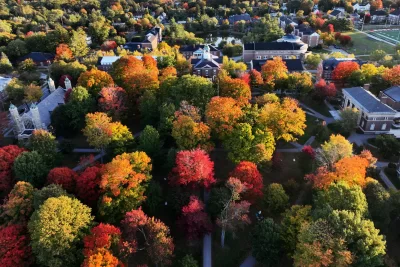The Campus Facilities Master Plan identified the need to improve the quality and reduce the density of Bates student housing. Subsequently, Bates planned to renovate or replace space that housed approximately 750 students: 470 beds in wood-frame houses; 150 in Hedge and Roger Williams; and 130 in overtaxed dorms like Smith. Yet the College could not renovate living spaces without first creating new housing. This project was that first step.
Construction was completed in fall 2007 on a new 152-bed residence at Bates, located adjacent to Rand Hall. The new three-section facility provides much-needed new housing for students and a stronger sense of residential community west of College Street.
Project architect Shepley Bulfinch Richardson and Abbott envisioned a creative design providing the type of living our students like best – a mix of double and single rooms in “clusters” that evoke the sense of family within the small Frye Street homes.
The “cluster” concept
The residential idea underlying the building is a hybrid of traditional dorm and suite layouts — known at Bates as a “cluster.” Sleeping eight to 14 students, each cluster includes a common lounge and several single or double bedrooms. Where bedrooms in a typical dorm suite open onto a common room, the Bates version interposes a corridor between the two. Students walk down a corridor to get to the cluster’s lounge, a configuration offering enough space to hang out with close friends while encouraging new connections with others on the floor and in the building.
(For a fuller treatment of the cluster concept, read the story in the Summer 2005 issue of Bates Magazine, or online at www.bates.edu/residence-2007.xml)
Cost
The facility cost approximately $17.5 million, with gifts from alumni, parents and friends supporting a portion of the cost, and borrowing through the state of Maine covering the balance.


